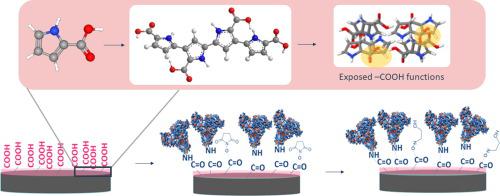当前位置:
X-MOL 学术
›
Bioelectrochemistry
›
论文详情
Our official English website, www.x-mol.net, welcomes your
feedback! (Note: you will need to create a separate account there.)
Covalent immobilization of delipidated human serum albumin on poly(pyrrole-2-carboxylic) acid film for the impedimetric detection of perfluorooctanoic acid.
Bioelectrochemistry ( IF 4.8 ) Pub Date : 2020-04-26 , DOI: 10.1016/j.bioelechem.2020.107540 Giulia Moro 1 , Fabio Bottari 2 , Stefano Liberi 3 , Sonia Covaceuszach 4 , Alberto Cassetta 4 , Alessandro Angelini 5 , Karolien De Wael 2 , Ligia Maria Moretto 3
Bioelectrochemistry ( IF 4.8 ) Pub Date : 2020-04-26 , DOI: 10.1016/j.bioelechem.2020.107540 Giulia Moro 1 , Fabio Bottari 2 , Stefano Liberi 3 , Sonia Covaceuszach 4 , Alberto Cassetta 4 , Alessandro Angelini 5 , Karolien De Wael 2 , Ligia Maria Moretto 3
Affiliation

|
The immobilization of biomolecules at screen printed electrodes for biosensing applications is still an open challenge. To enrich the toolbox of bioelectrochemists, graphite screen printed electrodes (G-SPE) were modified with an electropolymerized film of pyrrole-2-carboxilic acid (Py-2-COOH), a pyrrole derivative rich in carboxylic acid functional groups. These functionalities are suitable for the covalent immobilization of biomolecular recognition layers. The electropolymerization was first optimized to obtain stable and conductive polymeric films, comparing two different electrolytes: sodium dodecyl sulphate (SDS) and sodium perchlorate. The G-SPE modified with Py-2-COOH in 0.1 M SDS solution showed the required properties and were further tested. A proof-of-concept study for the development of an impedimetric sensor for perfluorooctanoic acid (PFOA) was carried out using the delipidated human serum albumin (hSA) as bioreceptor. The data interpretation was supported by size exclusion chromatography and small-angle X-ray scattering (SEC-SAXS) analysis of the bioreceptor-target complex and the preliminary results suggest the possibility to further develop this biosensing strategy for toxicological and analytical studies.
中文翻译:

共脂质固定的脂质人血清白蛋白在聚吡咯-2-羧酸膜上,用于全氟辛酸的阻抗检测。
将生物分子固定在丝网印刷电极上以用于生物传感应用仍然是一个开放的挑战。为了丰富生物化学家的工具箱,用吡咯-2-羧酸(Py-2-COOH)(富含羧酸官能团的吡咯衍生物)的电聚合膜修饰了石墨丝网印刷电极(G-SPE)。这些功能适合于生物分子识别层的共价固定。首先,通过比较两种不同的电解质:十二烷基硫酸钠(SDS)和高氯酸钠,对电聚合进行优化,以获得稳定且导电的聚合物膜。在0.1 M SDS溶液中用Py-2-COOH改性的G-SPE显示出所需的性能,并进行了进一步测试。使用脱脂人血清白蛋白(hSA)作为生物受体,进行了用于开发全氟辛酸(PFOA)阻抗传感器的概念验证研究。尺寸排阻色谱法和小角度X射线散射(SEC-SAXS)分析生物受体-靶标复合物支持了数据解释,初步结果表明有可能进一步发展这种生物传感策略进行毒理学和分析研究。
更新日期:2020-04-26
中文翻译:

共脂质固定的脂质人血清白蛋白在聚吡咯-2-羧酸膜上,用于全氟辛酸的阻抗检测。
将生物分子固定在丝网印刷电极上以用于生物传感应用仍然是一个开放的挑战。为了丰富生物化学家的工具箱,用吡咯-2-羧酸(Py-2-COOH)(富含羧酸官能团的吡咯衍生物)的电聚合膜修饰了石墨丝网印刷电极(G-SPE)。这些功能适合于生物分子识别层的共价固定。首先,通过比较两种不同的电解质:十二烷基硫酸钠(SDS)和高氯酸钠,对电聚合进行优化,以获得稳定且导电的聚合物膜。在0.1 M SDS溶液中用Py-2-COOH改性的G-SPE显示出所需的性能,并进行了进一步测试。使用脱脂人血清白蛋白(hSA)作为生物受体,进行了用于开发全氟辛酸(PFOA)阻抗传感器的概念验证研究。尺寸排阻色谱法和小角度X射线散射(SEC-SAXS)分析生物受体-靶标复合物支持了数据解释,初步结果表明有可能进一步发展这种生物传感策略进行毒理学和分析研究。











































 京公网安备 11010802027423号
京公网安备 11010802027423号